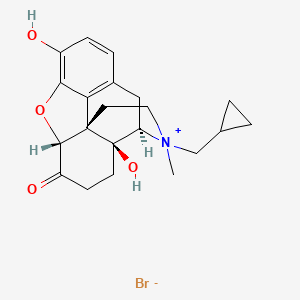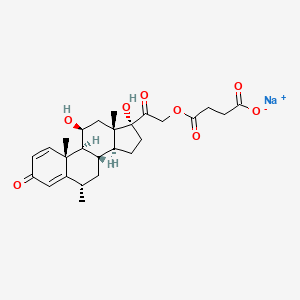
Metronidazol
Übersicht
Beschreibung
- Metronidazol, unter Markennamen wie Flagyl verkauft, ist ein Antibiotikum und ein Antiprotozoikum.
- Es wird zur Behandlung verschiedener Infektionen eingesetzt, darunter Beckenentzündung, Endokarditis, bakterielle Vaginose, Dracunculiasis, Giardiasis, Trichomoniasis und Amöbiasis .
- This compound ist wirksam gegen anaerobe Bakterien und bestimmte Parasiten.
Wirkmechanismus
Target of Action
Metronidazole, a nitroimidazole antibiotic, primarily targets anaerobic bacteria and protozoa . It is frequently used to treat gastrointestinal infections, trichomoniasis, giardiasis, and amebiasis .
Mode of Action
Metronidazole is a prodrug that is reductively activated under low oxygen tension, leading to imidazole fragmentation and cytotoxicity . It enters the cells of anaerobic bacteria and protozoa, where it is reduced by the pyruvate:ferredoxin oxidoreductase system . This reduction alters its chemical structure, creating a concentration gradient that drives uptake of more drug and promotes the formation of intermediate compounds and free radicals that are toxic to the cell .
Biochemical Pathways
The reduction of metronidazole in the cell leads to the production of toxic intermediates that interact with cellular components, causing cell death . It is believed that these intermediates indirectly inhibit DNA synthesis and repair of existing DNA .
Pharmacokinetics
Metronidazole is absorbed into the body similarly for both oral and intravenous dosage forms . Following oral administration, the peak plasma concentration is reached between 1–2 hours . The clearance of metronidazole in the kidneys is estimated at 10 mL/min/1.73 m2, and the total clearance from serum is about 2.1 to 6.4 L/h/kg . Dose adjustments may be required in patients with hepatic impairment, as clearance is impaired in these patients .
Result of Action
The result of metronidazole’s action is the death of the targeted anaerobic bacteria and protozoa. The toxic intermediates produced by the reduction of metronidazole interact with the DNA of these organisms, causing a loss of the helical DNA structure, strand breakage, and ultimately, cell death .
Action Environment
Environmental factors can influence the action, efficacy, and stability of metronidazole. For instance, the low oxygen tension in the environment of anaerobic bacteria and protozoa is crucial for the reductive activation of metronidazole . Additionally, changes in the gastrointestinal microbiome after metronidazole administration can also influence its action .
Wissenschaftliche Forschungsanwendungen
Medizin: Metronidazol wird in der Medizin häufig zur Behandlung von anaeroben bakteriellen Infektionen, Protozoeninfektionen und bestimmten sexuell übertragbaren Infektionen eingesetzt.
Zahnmedizin: Es wird bei oralen Infektionen und Parodontalerkrankungen eingesetzt.
Veterinärmedizin: this compound wird auch in der Veterinärpraxis eingesetzt.
Wirkmechanismus
- This compound gelangt in anaerobe Bakterien, wo es aktiviert und zu einem kurzlebigen Nitroso-Radikal reduziert wird.
- Dieses Radikal interagiert mit DNA, wodurch der Verlust der helikalen Struktur, Strangbruch und der Tod von Bakterien verursacht werden.
Vorbereitungsmethoden
Synthesewege: Metronidazol kann durch verschiedene Verfahren synthetisiert werden, darunter die Reduktion von 2-Methyl-5-Nitroimidazol mit Hydrazin oder Natriumborhydrid.
Industrielle Produktion: Die kommerzielle Produktion umfasst die chemische Synthese, wobei die Nitrogruppe unter anaeroben Bedingungen zu einer Aminogruppe reduziert wird.
Analyse Chemischer Reaktionen
Reaktionen: Metronidazol unterliegt verschiedenen Reaktionen, darunter Reduktion, Substitution und Cyclisierung.
Häufige Reagenzien: Reduktionsmittel wie Hydrazin oder Natriumborhydrid werden für den Reduktionsschritt verwendet.
Hauptprodukte: Die Reduktion der Nitrogruppe ergibt das Aminoderivat, welches die aktive Form von this compound ist.
Vergleich Mit ähnlichen Verbindungen
- Metronidazol ist aufgrund seiner doppelten Wirkung gegen Bakterien und Protozoen einzigartig.
- Zu ähnlichen Verbindungen gehören Tinidazol und Secnidazol .
Eigenschaften
IUPAC Name |
2-(2-methyl-5-nitroimidazol-1-yl)ethanol | |
|---|---|---|
| Source | PubChem | |
| URL | https://pubchem.ncbi.nlm.nih.gov | |
| Description | Data deposited in or computed by PubChem | |
InChI |
InChI=1S/C6H9N3O3/c1-5-7-4-6(9(11)12)8(5)2-3-10/h4,10H,2-3H2,1H3 | |
| Source | PubChem | |
| URL | https://pubchem.ncbi.nlm.nih.gov | |
| Description | Data deposited in or computed by PubChem | |
InChI Key |
VAOCPAMSLUNLGC-UHFFFAOYSA-N | |
| Source | PubChem | |
| URL | https://pubchem.ncbi.nlm.nih.gov | |
| Description | Data deposited in or computed by PubChem | |
Canonical SMILES |
CC1=NC=C(N1CCO)[N+](=O)[O-] | |
| Source | PubChem | |
| URL | https://pubchem.ncbi.nlm.nih.gov | |
| Description | Data deposited in or computed by PubChem | |
Molecular Formula |
C6H9N3O3 | |
| Record name | METRONIDAZOLE | |
| Source | CAMEO Chemicals | |
| URL | https://cameochemicals.noaa.gov/chemical/20708 | |
| Description | CAMEO Chemicals is a chemical database designed for people who are involved in hazardous material incident response and planning. CAMEO Chemicals contains a library with thousands of datasheets containing response-related information and recommendations for hazardous materials that are commonly transported, used, or stored in the United States. CAMEO Chemicals was developed by the National Oceanic and Atmospheric Administration's Office of Response and Restoration in partnership with the Environmental Protection Agency's Office of Emergency Management. | |
| Explanation | CAMEO Chemicals and all other CAMEO products are available at no charge to those organizations and individuals (recipients) responsible for the safe handling of chemicals. However, some of the chemical data itself is subject to the copyright restrictions of the companies or organizations that provided the data. | |
| Record name | metronidazole | |
| Source | Wikipedia | |
| URL | https://en.wikipedia.org/wiki/Metronidazole | |
| Description | Chemical information link to Wikipedia. | |
| Source | PubChem | |
| URL | https://pubchem.ncbi.nlm.nih.gov | |
| Description | Data deposited in or computed by PubChem | |
Related CAS |
69198-10-3 (mono-hydrochloride) | |
| Record name | Metronidazole [USAN:USP:INN:BAN:JAN] | |
| Source | ChemIDplus | |
| URL | https://pubchem.ncbi.nlm.nih.gov/substance/?source=chemidplus&sourceid=0000443481 | |
| Description | ChemIDplus is a free, web search system that provides access to the structure and nomenclature authority files used for the identification of chemical substances cited in National Library of Medicine (NLM) databases, including the TOXNET system. | |
DSSTOX Substance ID |
DTXSID2020892 | |
| Record name | Metronidazole | |
| Source | EPA DSSTox | |
| URL | https://comptox.epa.gov/dashboard/DTXSID2020892 | |
| Description | DSSTox provides a high quality public chemistry resource for supporting improved predictive toxicology. | |
Molecular Weight |
171.15 g/mol | |
| Source | PubChem | |
| URL | https://pubchem.ncbi.nlm.nih.gov | |
| Description | Data deposited in or computed by PubChem | |
Physical Description |
Metronidazole is a white to pale-yellow crystalline powder with a slight odor. Bitter and saline taste. pH (saturated aqueous solution) about 6.5. (NTP, 1992), Solid | |
| Record name | METRONIDAZOLE | |
| Source | CAMEO Chemicals | |
| URL | https://cameochemicals.noaa.gov/chemical/20708 | |
| Description | CAMEO Chemicals is a chemical database designed for people who are involved in hazardous material incident response and planning. CAMEO Chemicals contains a library with thousands of datasheets containing response-related information and recommendations for hazardous materials that are commonly transported, used, or stored in the United States. CAMEO Chemicals was developed by the National Oceanic and Atmospheric Administration's Office of Response and Restoration in partnership with the Environmental Protection Agency's Office of Emergency Management. | |
| Explanation | CAMEO Chemicals and all other CAMEO products are available at no charge to those organizations and individuals (recipients) responsible for the safe handling of chemicals. However, some of the chemical data itself is subject to the copyright restrictions of the companies or organizations that provided the data. | |
| Record name | Metronidazole | |
| Source | Human Metabolome Database (HMDB) | |
| URL | http://www.hmdb.ca/metabolites/HMDB0015052 | |
| Description | The Human Metabolome Database (HMDB) is a freely available electronic database containing detailed information about small molecule metabolites found in the human body. | |
| Explanation | HMDB is offered to the public as a freely available resource. Use and re-distribution of the data, in whole or in part, for commercial purposes requires explicit permission of the authors and explicit acknowledgment of the source material (HMDB) and the original publication (see the HMDB citing page). We ask that users who download significant portions of the database cite the HMDB paper in any resulting publications. | |
Solubility |
>25.7 [ug/mL] (The mean of the results at pH 7.4), less than 1 mg/mL at 68 °F (NTP, 1992), g/100 ml at 20 °C: 1.0 in water, 0.5 in ethanol, less than 0.05 in ether, chloroform; sol in dilute acids; sparingly sol in dimethylformamide, In water, 11,000 mg/L at 25 °C, 5.92e+00 g/L | |
| Record name | SID855672 | |
| Source | Burnham Center for Chemical Genomics | |
| URL | https://pubchem.ncbi.nlm.nih.gov/bioassay/1996#section=Data-Table | |
| Description | Aqueous solubility in buffer at pH 7.4 | |
| Record name | METRONIDAZOLE | |
| Source | CAMEO Chemicals | |
| URL | https://cameochemicals.noaa.gov/chemical/20708 | |
| Description | CAMEO Chemicals is a chemical database designed for people who are involved in hazardous material incident response and planning. CAMEO Chemicals contains a library with thousands of datasheets containing response-related information and recommendations for hazardous materials that are commonly transported, used, or stored in the United States. CAMEO Chemicals was developed by the National Oceanic and Atmospheric Administration's Office of Response and Restoration in partnership with the Environmental Protection Agency's Office of Emergency Management. | |
| Explanation | CAMEO Chemicals and all other CAMEO products are available at no charge to those organizations and individuals (recipients) responsible for the safe handling of chemicals. However, some of the chemical data itself is subject to the copyright restrictions of the companies or organizations that provided the data. | |
| Record name | METRONIDAZOLE | |
| Source | Hazardous Substances Data Bank (HSDB) | |
| URL | https://pubchem.ncbi.nlm.nih.gov/source/hsdb/3129 | |
| Description | The Hazardous Substances Data Bank (HSDB) is a toxicology database that focuses on the toxicology of potentially hazardous chemicals. It provides information on human exposure, industrial hygiene, emergency handling procedures, environmental fate, regulatory requirements, nanomaterials, and related areas. The information in HSDB has been assessed by a Scientific Review Panel. | |
| Record name | Metronidazole | |
| Source | Human Metabolome Database (HMDB) | |
| URL | http://www.hmdb.ca/metabolites/HMDB0015052 | |
| Description | The Human Metabolome Database (HMDB) is a freely available electronic database containing detailed information about small molecule metabolites found in the human body. | |
| Explanation | HMDB is offered to the public as a freely available resource. Use and re-distribution of the data, in whole or in part, for commercial purposes requires explicit permission of the authors and explicit acknowledgment of the source material (HMDB) and the original publication (see the HMDB citing page). We ask that users who download significant portions of the database cite the HMDB paper in any resulting publications. | |
Mechanism of Action |
The exact mechanism of action of metronidazole has not been fully established, however, it is possible that an intermediate in the reduction of metronidazole which is only made by anaerobic bacteria and protozoa, binds deoxyribonucleic acid and electron-transport proteins of organisms, blocking nucleic acid synthesis. After administration, metronidazole enters cells by passive diffusion. Following this, ferredoxin or flavodoxin reduce its nitro group to nitro radicals. The redox potential of the electron transport portions of anaerobic or microaerophilic microorganisms renders metronidazole selective to these organisms, which cause nitro group reduction, leading to the production of toxic metabolites. These include N-(2-hydroxyethyl) oxamic acid and acetamide, which may damage DNA of replicating organisms., Microbicidal; active against most obligate anaerobic bacteria and protozoa by undergoing intracellular chemical reduction via mechanisms unique to anaerobic metabolism. Reduced metronidazole, which is cytotoxic but short-lived, interacts with DNA to cause loss of helical structure, strand breakage, and resultant inhibition of nucleic acid synthesis and cell death., Metronidazole is bactericidal, amebicidal, and trichomonacidal in action. The exact mechanism of action of the drug has not been fully elucidated. Metronidazole is un-ionized at physiologic pH and is readily taken up by anaerobic organisms or cells. In susceptible organisms or cells, metronidazole is reduced by low-redox-potential electron transport proteins (e.g., nitroreductases such as ferredoxin) to unidentified polar product(s) which lack the nitro group. The reduction product(s) appears to be responsible for the cytotoxic and antimicrobial effects of the drug which include disruption of DNA and inhibition of nucleic acid synthesis. Metronidazole is equally effective against dividing and nondividing cells., In in vivo studies in rats given metronidazole in dosages of 2-4 mg/100 g of body weight, the drug reportedly inhibited the development of formalin-induced edema in the rat paw. In vitro in neutrophils, metronidazole has a dose-dependent inhibitory effect on generation of hydrogen peroxide and hydroxyl radicals, oxidants that may cause tissue injury at the site of inflammation. This antioxidant effect appears to be caused by a direct effect on neutrophil function and may contribute to the drug's anti-inflammatory effect in vivo., Results of in vitro studies using leukocytes obtained from patients with Crohn's disease indicate that exposing the cells to metronidazole concentrations of 10 or 50 mcg/mL improved both spontaneous and induced leukocyte migration in cells that previously exhibited reduced migration; the drug had no effect on leukocytes obtained from healthy adults or patients with Crohn's disease when the cells exhibited normal migration prior to exposure to the drug. This effect on leukocyte migration also was observed in vivo in adults with Crohn's disease who received a single 400-mg dose of metronidazole. It has been suggested that metronidazole may increase leukocyte migration by a direct effect on the leukocytes, possibly by causing the release of surface-bound immune complexes from the cell surface. | |
| Record name | Metronidazole | |
| Source | DrugBank | |
| URL | https://www.drugbank.ca/drugs/DB00916 | |
| Description | The DrugBank database is a unique bioinformatics and cheminformatics resource that combines detailed drug (i.e. chemical, pharmacological and pharmaceutical) data with comprehensive drug target (i.e. sequence, structure, and pathway) information. | |
| Explanation | Creative Common's Attribution-NonCommercial 4.0 International License (http://creativecommons.org/licenses/by-nc/4.0/legalcode) | |
| Record name | METRONIDAZOLE | |
| Source | Hazardous Substances Data Bank (HSDB) | |
| URL | https://pubchem.ncbi.nlm.nih.gov/source/hsdb/3129 | |
| Description | The Hazardous Substances Data Bank (HSDB) is a toxicology database that focuses on the toxicology of potentially hazardous chemicals. It provides information on human exposure, industrial hygiene, emergency handling procedures, environmental fate, regulatory requirements, nanomaterials, and related areas. The information in HSDB has been assessed by a Scientific Review Panel. | |
Color/Form |
Cream-colored crystals, WHITE TO PALE YELLOW CRYSTALS OR CRYSTALLINE POWDER | |
CAS No. |
443-48-1, 56010-45-8 | |
| Record name | METRONIDAZOLE | |
| Source | CAMEO Chemicals | |
| URL | https://cameochemicals.noaa.gov/chemical/20708 | |
| Description | CAMEO Chemicals is a chemical database designed for people who are involved in hazardous material incident response and planning. CAMEO Chemicals contains a library with thousands of datasheets containing response-related information and recommendations for hazardous materials that are commonly transported, used, or stored in the United States. CAMEO Chemicals was developed by the National Oceanic and Atmospheric Administration's Office of Response and Restoration in partnership with the Environmental Protection Agency's Office of Emergency Management. | |
| Explanation | CAMEO Chemicals and all other CAMEO products are available at no charge to those organizations and individuals (recipients) responsible for the safe handling of chemicals. However, some of the chemical data itself is subject to the copyright restrictions of the companies or organizations that provided the data. | |
| Record name | Metronidazole | |
| Source | CAS Common Chemistry | |
| URL | https://commonchemistry.cas.org/detail?cas_rn=443-48-1 | |
| Description | CAS Common Chemistry is an open community resource for accessing chemical information. Nearly 500,000 chemical substances from CAS REGISTRY cover areas of community interest, including common and frequently regulated chemicals, and those relevant to high school and undergraduate chemistry classes. This chemical information, curated by our expert scientists, is provided in alignment with our mission as a division of the American Chemical Society. | |
| Explanation | The data from CAS Common Chemistry is provided under a CC-BY-NC 4.0 license, unless otherwise stated. | |
| Record name | 1H-Imidazole-1-ethanol, 2-methyl-5-nitro-, radical ion(1-) | |
| Source | CAS Common Chemistry | |
| URL | https://commonchemistry.cas.org/detail?cas_rn=56010-45-8 | |
| Description | CAS Common Chemistry is an open community resource for accessing chemical information. Nearly 500,000 chemical substances from CAS REGISTRY cover areas of community interest, including common and frequently regulated chemicals, and those relevant to high school and undergraduate chemistry classes. This chemical information, curated by our expert scientists, is provided in alignment with our mission as a division of the American Chemical Society. | |
| Explanation | The data from CAS Common Chemistry is provided under a CC-BY-NC 4.0 license, unless otherwise stated. | |
| Record name | Metronidazole [USAN:USP:INN:BAN:JAN] | |
| Source | ChemIDplus | |
| URL | https://pubchem.ncbi.nlm.nih.gov/substance/?source=chemidplus&sourceid=0000443481 | |
| Description | ChemIDplus is a free, web search system that provides access to the structure and nomenclature authority files used for the identification of chemical substances cited in National Library of Medicine (NLM) databases, including the TOXNET system. | |
| Record name | Metronidazole | |
| Source | DrugBank | |
| URL | https://www.drugbank.ca/drugs/DB00916 | |
| Description | The DrugBank database is a unique bioinformatics and cheminformatics resource that combines detailed drug (i.e. chemical, pharmacological and pharmaceutical) data with comprehensive drug target (i.e. sequence, structure, and pathway) information. | |
| Explanation | Creative Common's Attribution-NonCommercial 4.0 International License (http://creativecommons.org/licenses/by-nc/4.0/legalcode) | |
| Record name | metronidazole | |
| Source | DTP/NCI | |
| URL | https://dtp.cancer.gov/dtpstandard/servlet/dwindex?searchtype=NSC&outputformat=html&searchlist=757118 | |
| Description | The NCI Development Therapeutics Program (DTP) provides services and resources to the academic and private-sector research communities worldwide to facilitate the discovery and development of new cancer therapeutic agents. | |
| Explanation | Unless otherwise indicated, all text within NCI products is free of copyright and may be reused without our permission. Credit the National Cancer Institute as the source. | |
| Record name | metronidazole | |
| Source | DTP/NCI | |
| URL | https://dtp.cancer.gov/dtpstandard/servlet/dwindex?searchtype=NSC&outputformat=html&searchlist=69587 | |
| Description | The NCI Development Therapeutics Program (DTP) provides services and resources to the academic and private-sector research communities worldwide to facilitate the discovery and development of new cancer therapeutic agents. | |
| Explanation | Unless otherwise indicated, all text within NCI products is free of copyright and may be reused without our permission. Credit the National Cancer Institute as the source. | |
| Record name | metronidazole | |
| Source | DTP/NCI | |
| URL | https://dtp.cancer.gov/dtpstandard/servlet/dwindex?searchtype=NSC&outputformat=html&searchlist=50364 | |
| Description | The NCI Development Therapeutics Program (DTP) provides services and resources to the academic and private-sector research communities worldwide to facilitate the discovery and development of new cancer therapeutic agents. | |
| Explanation | Unless otherwise indicated, all text within NCI products is free of copyright and may be reused without our permission. Credit the National Cancer Institute as the source. | |
| Record name | Metronidazole | |
| Source | EPA DSSTox | |
| URL | https://comptox.epa.gov/dashboard/DTXSID2020892 | |
| Description | DSSTox provides a high quality public chemistry resource for supporting improved predictive toxicology. | |
| Record name | Metronidazole | |
| Source | European Chemicals Agency (ECHA) | |
| URL | https://echa.europa.eu/substance-information/-/substanceinfo/100.006.489 | |
| Description | The European Chemicals Agency (ECHA) is an agency of the European Union which is the driving force among regulatory authorities in implementing the EU's groundbreaking chemicals legislation for the benefit of human health and the environment as well as for innovation and competitiveness. | |
| Explanation | Use of the information, documents and data from the ECHA website is subject to the terms and conditions of this Legal Notice, and subject to other binding limitations provided for under applicable law, the information, documents and data made available on the ECHA website may be reproduced, distributed and/or used, totally or in part, for non-commercial purposes provided that ECHA is acknowledged as the source: "Source: European Chemicals Agency, http://echa.europa.eu/". Such acknowledgement must be included in each copy of the material. ECHA permits and encourages organisations and individuals to create links to the ECHA website under the following cumulative conditions: Links can only be made to webpages that provide a link to the Legal Notice page. | |
| Record name | METRONIDAZOLE | |
| Source | FDA Global Substance Registration System (GSRS) | |
| URL | https://gsrs.ncats.nih.gov/ginas/app/beta/substances/140QMO216E | |
| Description | The FDA Global Substance Registration System (GSRS) enables the efficient and accurate exchange of information on what substances are in regulated products. Instead of relying on names, which vary across regulatory domains, countries, and regions, the GSRS knowledge base makes it possible for substances to be defined by standardized, scientific descriptions. | |
| Explanation | Unless otherwise noted, the contents of the FDA website (www.fda.gov), both text and graphics, are not copyrighted. They are in the public domain and may be republished, reprinted and otherwise used freely by anyone without the need to obtain permission from FDA. Credit to the U.S. Food and Drug Administration as the source is appreciated but not required. | |
| Record name | METRONIDAZOLE | |
| Source | Hazardous Substances Data Bank (HSDB) | |
| URL | https://pubchem.ncbi.nlm.nih.gov/source/hsdb/3129 | |
| Description | The Hazardous Substances Data Bank (HSDB) is a toxicology database that focuses on the toxicology of potentially hazardous chemicals. It provides information on human exposure, industrial hygiene, emergency handling procedures, environmental fate, regulatory requirements, nanomaterials, and related areas. The information in HSDB has been assessed by a Scientific Review Panel. | |
| Record name | Metronidazole | |
| Source | Human Metabolome Database (HMDB) | |
| URL | http://www.hmdb.ca/metabolites/HMDB0015052 | |
| Description | The Human Metabolome Database (HMDB) is a freely available electronic database containing detailed information about small molecule metabolites found in the human body. | |
| Explanation | HMDB is offered to the public as a freely available resource. Use and re-distribution of the data, in whole or in part, for commercial purposes requires explicit permission of the authors and explicit acknowledgment of the source material (HMDB) and the original publication (see the HMDB citing page). We ask that users who download significant portions of the database cite the HMDB paper in any resulting publications. | |
Melting Point |
316 to 320 °F (NTP, 1992), 158-160 °C, 160 °C | |
| Record name | METRONIDAZOLE | |
| Source | CAMEO Chemicals | |
| URL | https://cameochemicals.noaa.gov/chemical/20708 | |
| Description | CAMEO Chemicals is a chemical database designed for people who are involved in hazardous material incident response and planning. CAMEO Chemicals contains a library with thousands of datasheets containing response-related information and recommendations for hazardous materials that are commonly transported, used, or stored in the United States. CAMEO Chemicals was developed by the National Oceanic and Atmospheric Administration's Office of Response and Restoration in partnership with the Environmental Protection Agency's Office of Emergency Management. | |
| Explanation | CAMEO Chemicals and all other CAMEO products are available at no charge to those organizations and individuals (recipients) responsible for the safe handling of chemicals. However, some of the chemical data itself is subject to the copyright restrictions of the companies or organizations that provided the data. | |
| Record name | Metronidazole | |
| Source | DrugBank | |
| URL | https://www.drugbank.ca/drugs/DB00916 | |
| Description | The DrugBank database is a unique bioinformatics and cheminformatics resource that combines detailed drug (i.e. chemical, pharmacological and pharmaceutical) data with comprehensive drug target (i.e. sequence, structure, and pathway) information. | |
| Explanation | Creative Common's Attribution-NonCommercial 4.0 International License (http://creativecommons.org/licenses/by-nc/4.0/legalcode) | |
| Record name | METRONIDAZOLE | |
| Source | Hazardous Substances Data Bank (HSDB) | |
| URL | https://pubchem.ncbi.nlm.nih.gov/source/hsdb/3129 | |
| Description | The Hazardous Substances Data Bank (HSDB) is a toxicology database that focuses on the toxicology of potentially hazardous chemicals. It provides information on human exposure, industrial hygiene, emergency handling procedures, environmental fate, regulatory requirements, nanomaterials, and related areas. The information in HSDB has been assessed by a Scientific Review Panel. | |
| Record name | Metronidazole | |
| Source | Human Metabolome Database (HMDB) | |
| URL | http://www.hmdb.ca/metabolites/HMDB0015052 | |
| Description | The Human Metabolome Database (HMDB) is a freely available electronic database containing detailed information about small molecule metabolites found in the human body. | |
| Explanation | HMDB is offered to the public as a freely available resource. Use and re-distribution of the data, in whole or in part, for commercial purposes requires explicit permission of the authors and explicit acknowledgment of the source material (HMDB) and the original publication (see the HMDB citing page). We ask that users who download significant portions of the database cite the HMDB paper in any resulting publications. | |
Retrosynthesis Analysis
AI-Powered Synthesis Planning: Our tool employs the Template_relevance Pistachio, Template_relevance Bkms_metabolic, Template_relevance Pistachio_ringbreaker, Template_relevance Reaxys, Template_relevance Reaxys_biocatalysis model, leveraging a vast database of chemical reactions to predict feasible synthetic routes.
One-Step Synthesis Focus: Specifically designed for one-step synthesis, it provides concise and direct routes for your target compounds, streamlining the synthesis process.
Accurate Predictions: Utilizing the extensive PISTACHIO, BKMS_METABOLIC, PISTACHIO_RINGBREAKER, REAXYS, REAXYS_BIOCATALYSIS database, our tool offers high-accuracy predictions, reflecting the latest in chemical research and data.
Strategy Settings
| Precursor scoring | Relevance Heuristic |
|---|---|
| Min. plausibility | 0.01 |
| Model | Template_relevance |
| Template Set | Pistachio/Bkms_metabolic/Pistachio_ringbreaker/Reaxys/Reaxys_biocatalysis |
| Top-N result to add to graph | 6 |
Feasible Synthetic Routes
Q1: How does Metronidazole exert its antimicrobial effect?
A1: Metronidazole is a prodrug that requires reductive activation within anaerobic or microaerophilic microorganisms. [] This process involves the reduction of its nitro group, likely by enzymes like thioredoxin reductase and pyruvate:ferredoxin oxidoreductase. [, ] This reduction generates cytotoxic metabolites that disrupt DNA synthesis and cause strand breakage, ultimately leading to cell death. [] It's important to note that this mechanism is selective for anaerobic bacteria due to their unique metabolic pathways and redox potential. []
Q2: Metronidazole is known for its activity against Trichomonas vaginalis. Can you elaborate on this?
A2: Research shows that Metronidazole disrupts the cellular redox system in Trichomonas vaginalis. [] Specifically, Metronidazole's metabolites form adducts with proteins involved in thioredoxin-mediated redox regulation, hindering essential processes and causing cell death. []
Q3: What is known about the stability of Metronidazole in different formulations?
A5: Research indicates that Metronidazole demonstrates good stability in various formulations. For instance, Metronidazole benzoate suspension in SyrSpend SF One-Step Suspension system remained stable for at least one year at ambient temperature and potentially two years under refrigerated conditions. [] Additionally, extemporaneously prepared Metronidazole cream exhibited stability for six months. []
Q4: Can you provide specific examples of Metronidazole's stability in intravenous admixtures?
A6: Studies have investigated the stability of Metronidazole in combination with other drugs. One study demonstrated that a mixture of Cefotaxime sodium (10 mg/mL) and Metronidazole (5 mg/mL) remained stable for 72 hours at 8°C in an intravenous admixture. [] Similarly, another study found that Cefepime hydrochloride and Metronidazole mixtures in various solutions and concentrations exhibited stability for varying durations at 4°C and 22-24°C when stored in polyvinyl chloride bags. [] These findings highlight the importance of considering storage conditions and specific drug combinations when assessing the stability of Metronidazole admixtures.
Q5: How does the polymerization process affect Metronidazole's release from Polymethylmethacrylate (PMMA) beads?
A7: Research has explored incorporating Metronidazole into PMMA beads for local drug delivery. [] Studies show that Metronidazole's elution from PMMA is dose-dependent. [] Interestingly, copolymerization of Metronidazole with Gentamicin sulfate within PMMA resulted in increased elution rates for both drugs. [] These findings suggest the potential for tailoring drug release profiles by manipulating drug concentrations and combinations during the polymerization process.
Q6: What is the prevalence of Metronidazole resistance, and are there alternative treatments?
A8: Metronidazole resistance is a growing concern. Studies show a high frequency of resistance among Campylobacter jejuni strains isolated from birds (82-100%), while resistance is less common in isolates from ruminants. [] For Helicobacter pylori infections, Furazolidone has been investigated as an alternative in patients with Metronidazole-resistant strains, showing promising eradication rates and good tolerability. []
Q7: Are there any natural alternatives to Metronidazole for conditions like bacterial vaginosis?
A9: A randomized clinical trial compared Mycocin vaginal cream, composed of garlic and thyme, to Metronidazole vaginal gel for treating bacterial vaginosis. [] The study found comparable clinical improvement in both groups, suggesting Mycocin as a potential alternative treatment option. [] This highlights the ongoing search for alternative therapies to combat antimicrobial resistance and potentially reduce side effects.
Haftungsausschluss und Informationen zu In-Vitro-Forschungsprodukten
Bitte beachten Sie, dass alle Artikel und Produktinformationen, die auf BenchChem präsentiert werden, ausschließlich zu Informationszwecken bestimmt sind. Die auf BenchChem zum Kauf angebotenen Produkte sind speziell für In-vitro-Studien konzipiert, die außerhalb lebender Organismen durchgeführt werden. In-vitro-Studien, abgeleitet von dem lateinischen Begriff "in Glas", beinhalten Experimente, die in kontrollierten Laborumgebungen unter Verwendung von Zellen oder Geweben durchgeführt werden. Es ist wichtig zu beachten, dass diese Produkte nicht als Arzneimittel oder Medikamente eingestuft sind und keine Zulassung der FDA für die Vorbeugung, Behandlung oder Heilung von medizinischen Zuständen, Beschwerden oder Krankheiten erhalten haben. Wir müssen betonen, dass jede Form der körperlichen Einführung dieser Produkte in Menschen oder Tiere gesetzlich strikt untersagt ist. Es ist unerlässlich, sich an diese Richtlinien zu halten, um die Einhaltung rechtlicher und ethischer Standards in Forschung und Experiment zu gewährleisten.
















